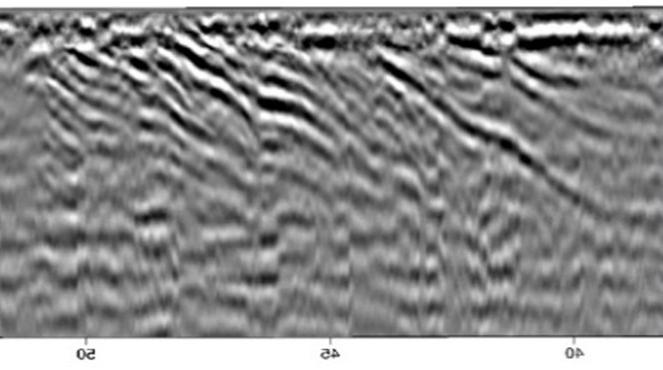Archaeological Geophysics Lab
Archaeological geophysics is the application of remote sensing methods such as ground-penetrating radar, magnetometry, electrical resistivity, and conductivity, to solve archaeological problems. These methods utilize instruments that measure various properties of soil, rock, and buried archaeological features. They are useful for locating and studying archaeological sites ranging from the small campsites of hunter gatherers to sprawling ancient cities. The instruments are carried or dragged above or at the ground surface, or utilize probes inserted into the ground. These methods are remarkable because they map buried features such as walls, hearths, burials, streets, dwellings, and other aspects of archaeological sites, without the expense of excavation. Subsequent excavations, if needed for research purposes, are targeted to specific features identified in the geophysics data.

Magnetometry data showing buried structures at an Early Bronze Age city in Turkey.
Instruments
The archaeological geophysics lab at UNC includes the following instruments:
- Hand-carried fluxgate magnetometer
- Cart-mounted, GPS-integrated fluxgate magnetometer array
- Ground-penetrating radar system with a full range of antennas
- Resistance meter
- Conductivity/magnetic susceptibility meter
- Base/rover GPS, and hand-held GPS system
- Total station
- Mavic Pro 2 UAV
Students receive training in the use of these instruments both in the classroom and the field. Past research projects include studies of sites in Colorado, New Mexico, Israel, Palestine, and Iraq.

Ground-penetrating radar data showing sloping layers of deposits at a Native American site in Colorado.
Program Support
The archaeological geophysics lab and associated instruction and research received support from and/or collaborated with:
- National Science Foundation, Major Research Instrumentation, Award # BCS-1229061
- National Geographic Society's Committee for Research and Exploration
- CARES Act
- University of Northern Colorado Provost Fund for Faculty Scholarship and Professional Development, Research Dissemination, and Faculty Development
- University of Northern Colorado Summer Support Initiative for Research, Scholarship, Creative Works, and Grant Writing
- Bar Ilan University
- Johns Hopkins University
- University of Chicago
Recent Publications of Archaeological Geophysics Research
2022 Schwartz, Glenn M., Andrew T. Creekmore III, Alexia Smith, Jill A. Weber, and Lyndelle Webster. Kurd Qaburstan on the Erbil Plain: Field Research 2016-2017 Iraq. DOI http://doi.org/10.1017/irq.2022.2
2022 Creekmore III, Andrew T. Report of Research Conducted in 2022 at the Belén Plaza Vieja Colonial Church site, Belen, NM. Prepared for Pamela Stone.
2021 Creekmore III, Andrew. T., and Maeir, Aren M., Philistine urban form at Tell es-Safi/Gath, Israel: a magnetometric perspective. Levant 53(2):1-22. DOI http://doi.org/10.1080/00758914.2021.1947647
2019 Creekmore III, Andrew T. Final Report of Geophysics Research Conducted at 5LR814, Loveland Colorado. Report prepared for Debbie Eley, City of Loveland Parks and Recreation Department.
2017 Schwartz, Glenn M., Christopher D. Brinker, Andrew T. Creekmore III, Marian H. Feldman, Alexia Smith, and Jill A. Weber. Excavations at Kurd Qaburstan, A Second Millennium BC Urban Site on the Erbil Plain. Iraq 79:213-255. DOI: http://doi.org/10.1017/irq.2017.2
2016 Whitcomb, Don, Ignacio Arce, Andrew Creekmore, and Michael Jennings. Khirbet al-Mafjar: New Excavations and Hypotheses for an Umayyad Monument. Near Eastern Archaeology 79(2):78-87. http://doi-org.unco.idm.oclc.org/10.5615/neareastarch.79.2.0078
2016 Creekmore III, Andrew T. Report on Archaeogeophysics Research Conducted at the Medina Cemetery, Loveland, CO. (5LR13223). Prepared for the Loveland Historical Society.
2016 Creekmore III, Andrew T. Final Report of geophysics, metal detector, and pedestrian survey conducted at the Fossil Creek site (5LR13041). Report prepared for Zac Wiebe, Larimer County Department of Natural Resources, Loveland, Colorado.
Contact Dr. Creekmore to learn more!















